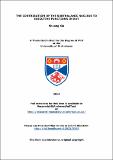Files in this item
The contribution of the subthalamic nucleus to executive functions in rat
Item metadata
| dc.contributor.advisor | Brown, Verity Joy | |
| dc.contributor.author | Xia, Shuang | |
| dc.coverage.spatial | 164 | en_US |
| dc.date.accessioned | 2014-10-15T15:26:59Z | |
| dc.date.available | 2014-10-15T15:26:59Z | |
| dc.date.issued | 2014-12-01 | |
| dc.identifier.uri | https://hdl.handle.net/10023/5545 | |
| dc.description.abstract | Lesions of the subthalamic nucleus (STN) alleviate the cardinal signs of idiopathic as well as MPTP-induced Parkinson’s disease in primates. For this reason, the STN is a target for clinical treatment of Parkinson’s disease using deep brain stimulation. Despite its small size, the STN plays a vital role in the cortico-basal ganglia-thalamic network. However, the functional features of the STN have yet to be fully uncovered. The research presented in this thesis examines the functions of the STN by measuring behavioural changes resulting from STN lesions in rats performing executive abilities. In the first experiment, a ‘signal change’ reaction time task was developed and the performance of humans and rats was compared. The main findings were that although humans and rats used different strategies in the task, the task did challenge the ability to inhibit unwanted responses. In the second and third experiments, the effects of bilateral lesions of the STN on performance of two variants of the ‘signal change’ task were examined. Rats with the STN lesions were able to inhibit responses when under stimulus control, but were less able to inhibit responses that were not under stimulus control. In the final experiment, the effects of lesions of the STN on inhibitory control in a nonmotor, cognitive domain were examined. Rats with STN lesions were not impaired on reversal learning, suggesting intact inhibition of previously rewarded responses. The rats with STN lesions did show impairments in selective attention which resulted in an inability to form an attentional set. Together, these findings challenge the conventional view that the STN simply plays a global inhibitory role. Rather, the contribution of the STN to inhibitory control is more complex and neither the motor nor the cognitive effects of the lesions are easily explained simply as a failure of inhibition. | en_US |
| dc.language.iso | en | en_US |
| dc.publisher | University of St Andrews | |
| dc.subject | Response control | en_US |
| dc.subject | Set-shifting | en_US |
| dc.subject | Inhibition | en_US |
| dc.subject | Subthalamic nucleus | en_US |
| dc.subject.lcc | QP383.3X5 | |
| dc.subject.lcsh | Subthalamus--Physiology | en_US |
| dc.subject.lcsh | Executive functions (Neuropsychology) | en_US |
| dc.subject.lcsh | Set (Psychology) | en_US |
| dc.subject.lcsh | Inhibition | en_US |
| dc.subject.lcsh | Rats--Behavior | en_US |
| dc.title | The contribution of the subthalamic nucleus to executive functions in rat | en_US |
| dc.type | Thesis | en_US |
| dc.type.qualificationlevel | Doctoral | en_US |
| dc.type.qualificationname | PhD Doctor of Philosophy | en_US |
| dc.publisher.institution | The University of St Andrews | en_US |
This item appears in the following Collection(s)
Items in the St Andrews Research Repository are protected by copyright, with all rights reserved, unless otherwise indicated.

